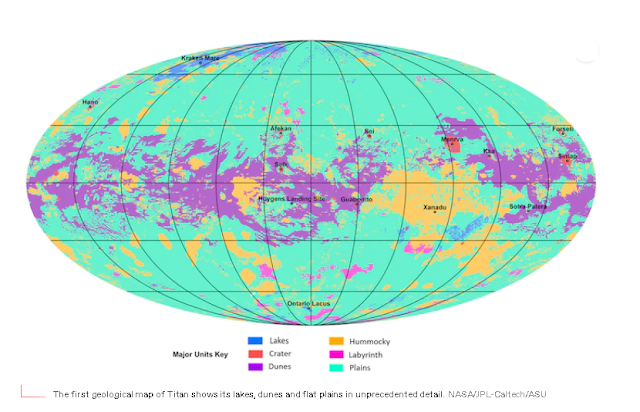For the first time, scientists have just seen Titan’s astounding surface.
In our Solar System, the biggest moon of Saturn is a rare environment. With its methane-filled lakes, ice-covered volcanoes, and underground tunnels, it seems to be a planet distinct from our own.
The first geomorphological map of Titan shows that, despite Titan’s stunning and varied topography, these features actually make it remarkably comparable to Earth.
With the exception of Earth, Titan is the only other world in the Solar System that is known to contain stable liquid on its surface. On the other side, Titan’s lakes, rivers, and oceans are composed of the liquid methane and ethane that fall from its clouds.

Titan is also the only moon with a significant atmosphere and air thick enough to allow a human to traverse its hostile terrain without a spacesuit (albeit you would have to deal with some extra challenges due to the methane rain and lakes).
Another intriguing aspect of Titan’s liquid is that under its frozen surface, there may be a layer of water that contains life.
The numerous lakes, dunes, craters, and grasslands are highlighted on this new map. The analysis suggests that these varied characteristics may have developed as a result of the same geological process that took place on Earth.

“Many surface features are similar and can be interpreted as products of the same geologic processes between Earth and Titan, despite the differences in materials, temperatures, and gravity fields,” Rosaly Lopes, a planetary geologist at NASA’s Jet Propulsion Laboratory in Pasadena, California, and the study’s lead author, said in a statement.
Utilizing information from NASA’s Cassini mission, the map was created. On October 15, 1997, Cassini was launched in order to study Saturn and its moons. Titan was the target of 120 flybys by Cassini.
The spacecraft’s 20-year mission was essentially over when it slammed into Saturn’s atmosphere on September 15, 2017.
Cassini used infrared technology to see Titan’s larger geological structures and radar imaging to peek through the planet’s thick atmosphere of methane and nitrogen.
David Williams, an associate research professor at Arizona State University and a co-author on the study, said in a statement that Titan is a geologically active world where hydrocarbons like methane and ethane replace water on Earth. These hydrocarbons fall as rain, travel via rivers and streams, gather in lakes and oceans, and then evaporate into the sky. It’s a very amazing planet!

NASA is preparing an expedition for 2026 to learn more about this extraordinary planet. Samples from the frozen moon will be collected and sent to Earth by the Dragonfly mission. Additionally, it is anticipated that signs of life will be found, which might be the first proof that humans are not as unusual in the cosmos as we think.
Reference(s): Nature Astronomy
Do not forget to share your opinion with us to provide you with the best posts !



0 Comments